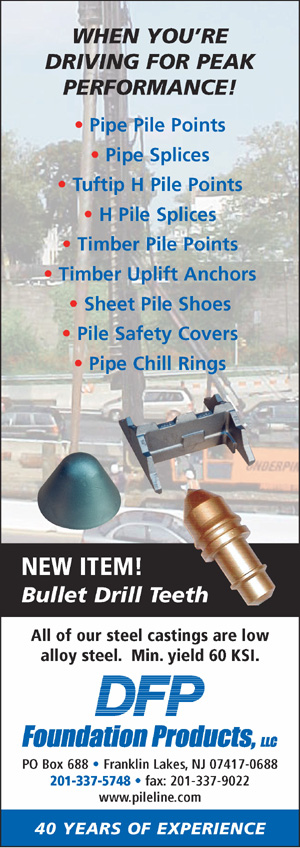

Are you getting what you paid for and what you need?
By Jack Dougherty
 Many
engineers in both the public and private sectors specify steel castings for
protection of pile tips for driven piles. In addition to specifying the castings,
many also specify the type of material to be supplied by the manufacturer. Some
engineers specify just the weight of the point. This makes little sense since
many points come to the job already attached to the pile. And even if the points
are delivered to the job unattached, very few inspectors would have any way
to check the weight of the castings. The weight of the point alone does not
indicate a good design. Many engineers neglect to specify any ASTM specification
for the casting, and when they do they neglect to specify the grade of steel
to be used.
Many
engineers in both the public and private sectors specify steel castings for
protection of pile tips for driven piles. In addition to specifying the castings,
many also specify the type of material to be supplied by the manufacturer. Some
engineers specify just the weight of the point. This makes little sense since
many points come to the job already attached to the pile. And even if the points
are delivered to the job unattached, very few inspectors would have any way
to check the weight of the castings. The weight of the point alone does not
indicate a good design. Many engineers neglect to specify any ASTM specification
for the casting, and when they do they neglect to specify the grade of steel
to be used.
DFP's H-777 H Pile Point is made from 90/60 cast steel.
In
general the minimum grade of mild carbon steel usually specified is ASTM A-27
grade 65/35 (a 65 ksi tensile and 35 ksi yield) this material came into use
for castings used for piling over fifty years ago. This may have made sense
at the time because the piling used usually had similar yield strength.
Today piling is driven harder and is made of higher-grade steel, likely 50 ksi yield material. Because of this fact, it makes little sense to use a 35 ksi drive shoe on a pile with yield strength of 50 ksi. The better specification would be ASTM A-148 grade 90/60. This material gives a minimum yield strength of 60 ksi. This is a far better match to the piling.
The question remains, are you getting what you paid for and what you need?
The ASTM A-27 specification contains several grades to choose from:
• The N-1 grade requires chemicals only and no heat-treating. No tensile or yield specified.
• The N-2 grade requires heat-treat but no mechanical testing. No tensile or yield specified.
• The U-60/30 grade mechanically tested but not heat-treated.
Grades 60/30, 65/35, 70/36 and 70/40 require heat-treat and mechanical test. Some suppliers do not require any ASTM specification be followed by their foundry. How they certify the material is a mystery.
DFP does not use the ASTM A-27 specification when supplying steel castings. We use ASTM A-148 90/60, this material is covered under the Standard Specification for Steel Castings, High Strength, for Structural Purposes. This specification also covers many grades of steel so it is important to specify the grade desired. The grade material used by DFP has a minimum tensile strength of 90 ksi and a minimum yield strength of 60 ksi. The specification requires the material to be heat-treated and to have mechanical as well as chemical tests be made. This material is more suitable to present conditions in the foundation industry and is far less susceptible to brittle fracture than a non heat-treated casting would be.
In my forty years in the foundation industry I have had piles tested in a laboratory to document failure and observed many pulled piles, some that were thought to be good piles because the driving was not difficult but for other reasons the pile had to be removed only to discover serious damage. Many times it is impossible to determine if a pile is damaged by observation alone. It is particularly more difficult with an H Pile. It makes good sense to use a quality product and little sense to use an inferior product or in some cases no protection.
How do you get quality products? The same way you get other quality products: check the drawings, check the submittals, and check the product on the job. Some suppliers over the years have shaved the weight of the castings to compete. This gets their cost down but there may be a price that someone will have to pay for a less than adequate casting.
© Copyright 2007 Pileline Publishing